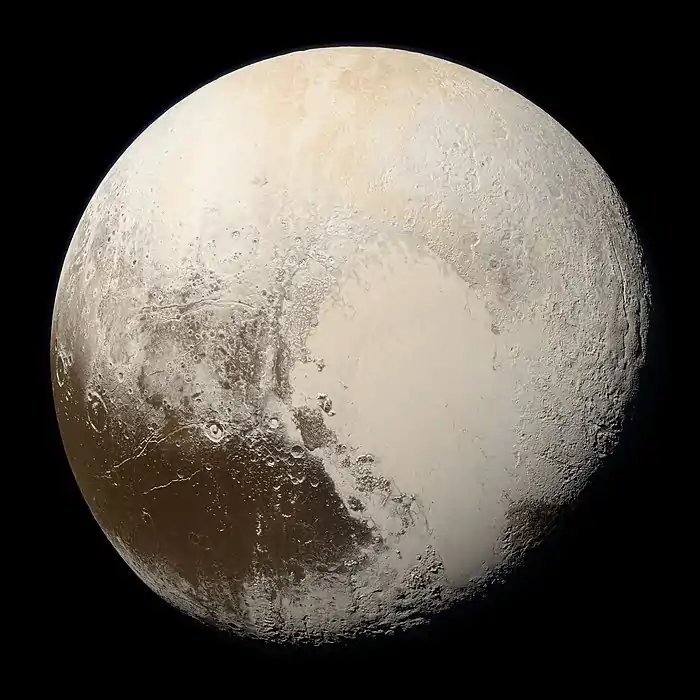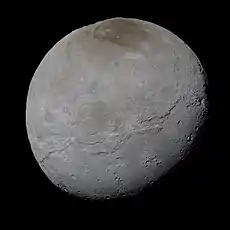341520 Mors–Somnus
341520 Mors–Somnus /ˌmɔːrs ˈsɒmnəs/, provisional designation 2007 TY430, is a trans-Neptunian object and binary system that resides in the Kuiper belt. It is classified as a plutino and measures approximately 100 kilometers in diameter.
| Discovery [1] | |
|---|---|
| Discovered by | S. S. Sheppard C. Trujillo |
| Discovery site | Mauna Kea Obs. |
| Discovery date | 14 October 2007 |
| Designations | |
| (341520) Mors-Somnus | |
Named after | Mors and Somnus (Roman mythology)[2] |
| 2007 TY430 | |
| TNO [1] · Plutino [3] | |
| Orbital characteristics [1] | |
| Epoch 4 September 2017 (JD 2458000.5) | |
| Uncertainty parameter 3 | |
| Observation arc | 6.12 yr (2,235 days) |
| Aphelion | 49.184 AU |
| Perihelion | 28.839 AU |
| 39.012 AU | |
| Eccentricity | 0.2607 |
| 243.67 yr (89,000 days) | |
| 0.4680° | |
| 0° 0m 14.4s / day | |
| Inclination | 11.304° |
| 196.75° | |
| 205.32° | |
| Known satellites | 1 [4] |
| Physical characteristics | |
| Dimensions | 102 km (derived)[4] 175.20 km (calculated)[5] <60 km (each component)[3] |
Mean density | >0.5 g/cm3[3] |
| 9.28±0.05 h[6] | |
| 0.10 (assumed)[5] 0.23[3] | |
| B–V = 1.290±0.014[3] V–R = 0.740±0.010[3] V–I = 1.370±0.014[3] C [5] | |
| 6.9[1][5] 6.94±0.02[3] | |
It was discovered on 14 October 2007, by American astronomers Scott Sheppard and Chad Trujillo with the Subaru telescope at Mauna Kea Observatories in Hawaii, United States. It was later named after the twins Mors and Somnus from Roman mythology.[2]
Orbit and binarity
Mors–Somnus is a small double plutino occupying the 3:2 mean motion resonance with Neptune.[3] The object is a wide optically resolved binary with the following orbital parameters:
| Semi-major axis, km | Eccentricity | Period, d | Inclination, degree |
| 21000 ± 160 | 0.1529 ± 0.0028 | 961.2 ± 4.6 | 15.68 ± 0.22 |
The components has almost equal size.
Physical properties
The total mass of the system is 7.90 ± 0.21×1017 kg. For a realistic minimal density of 0.5 g/cm3 the albedo is >0.17 and the size of the components is <60 km.[3] The Collaborative Asteroid Lightcurve Link assumes an albedo of 0.1 and calculates a diameter of 175.20 kilometers based on an absolute magnitude of 6.9.[5]
Mors–Somnus has an ultra-red spectrum in the visible and near-infrared parts of the spectrum. The colors of two components are indistinguishable from each other.[3] It demonstrates a double-peaked light curve with the period of about 9.28 hours and amplitude of 0.24. This indicates that either primary of secondary has an elongated shape and rotates non-synchronuosly.[6]
Evolution
The Mors–Somnus system is likely to be an escaped cold classical Kuiper Belt object.[3]
Naming
The minor planet was named after the mythological twin Roman gods of death (Mors) and sleep (Somnus).[2] The approved naming citation was published by the Minor Planet Center on 2 June 2015 (M.P.C. 94392).[7]
References
- "JPL Small-Body Database Browser: 341520 Mors-Somnus (2007 TY430)" (2013-11-26 last obs.). Jet Propulsion Laboratory. Retrieved 5 July 2017.
- "341520 Mors-Somnus (2007 TY430)". Minor Planet Center. Retrieved 5 July 2017.
- Sheppard, Scott S.; Ragozzine, Darin; Trujillo, Chadwick (March 2012). "2007 TY430: A Cold Classical Kuiper Belt Type Binary in the Plutino Population". The Astronomical Journal. 143 (3): 13. arXiv:1112.2708. Bibcode:2012AJ....143...58S. doi:10.1088/0004-6256/143/3/58.
- Wm. Robert Johnston (6 June 2015). "(341520) Mors-Somnus". Asteroids with Satellites Database—Johnston's Archive. Retrieved 5 July 2017.
- "LCDB Data for (341520) Mors–Somnus". Asteroid Lightcurve Database (LCDB). Retrieved 5 July 2017.
- Thirouin, A.; Noll, K. S.; Ortiz, J. L.; Morales, N. (September 2014). "Rotational properties of the binary and non-binary populations in the trans-Neptunian belt". Astronomy and Astrophysics. 569: 20. arXiv:1407.1214. Bibcode:2014A&A...569A...3T. doi:10.1051/0004-6361/201423567.
- "MPC/MPO/MPS Archive". Minor Planet Center. Retrieved 5 July 2017.
External links
- Asteroid Lightcurve Database (LCDB), query form (info)
- Dictionary of Minor Planet Names, Google books
- Discovery Circumstances: Numbered Minor Planets (340001)-(345000) – Minor Planet Center
- 341520 Mors–Somnus at AstDyS-2, Asteroids—Dynamic Site
- 341520 Mors–Somnus at the JPL Small-Body Database


